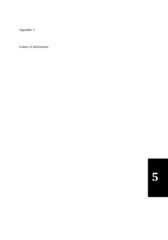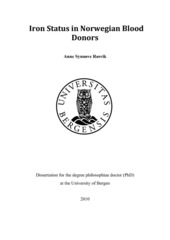| dc.contributor.author | Røsvik, Anne Synnøve | en_US |
| dc.date.accessioned | 2010-06-30T11:06:18Z | |
| dc.date.available | 2010-06-30T11:06:18Z | |
| dc.date.issued | 2010-05-07 | eng |
| dc.identifier.isbn | 978-82-308-1520-5 (print version) | en_US |
| dc.identifier.uri | https://hdl.handle.net/1956/3986 | |
| dc.description.abstract | Background and aims: Blood banks in Norway struggle to close the gap between need and supply of blood. The overall objective of this study was to investigate the iron status in blood donors. The aims of this thesis were first to compare the iron status in new blood donors in 1993-97 and in 2005-06, to describe possible changes in iron status. To describe the effect of four consecutive blood donations without iron supplementation for newly recruited donors was the second aim. The third objective was to study the effect of iron supplementation during the first week after blood donation. The fourth aim was to describe the distribution of HFE variants in blood donors with hereditary hemochromatosis, and compare changes in serum ferritin after blood donations between HFE variants and also between HFE variants and wild types. Results: Hb was decreased by 0.1 g/dL and serum ferritin was decreased by 4μg/L for women, both significant changes in the studied decade. This corresponded to the significantly increased new donor-rejection, from 14 % to 24 % for women. The differences in ferritin were most obvious for young women 18 - 45 years. Hb and serum ferritin decreased for women and serum ferritin decreased for men, with number of donations. This decrease was less prominent for longer intervals between donations, particularly between the third and fourth donations. Short term iron supplementation had a beneficial effect on iron status after donation. Donors with a serum ferritin below 50 μg/L should be offered iron, while donors with a serum ferritin above 80 μg/L do not need extra iron. Donors in the interval between these limits should be treated individually. Differences in serum ferritin were not statistically significant for women or men between HFE variants groups, and were significantly higher in the HFE variant-group than for wild types for women, but not for men. The serum ferritin ratio (ferritin at last donation divided by ferritin next to the last donation) was not significantly different between the HFE variant groups for any gender. The serum ferritin ratio was significantly larger for HFE variants than for wild types men, but not for women. Conclusion: The study revealed the need for more knowledge about the iron status in donors, the effect of donation interval, serum ferritin measurements and iron supplementation, differentiated to gender and age. Iron supplementation had a significant impact on the restoration of iron status after donation. The donors with hereditary hemochromatosis can augment the blood supply. | en_US |
| dc.language.iso | eng | eng |
| dc.publisher | The University of Bergen | eng |
| dc.relation.haspart | Paper I: Vox Sanguinis 96(1), Røsvik, A. S.; Hervig, T.; Wentzel-Larsen, T.; Ulvik, R. J., Iron status in Norwegian blood donors: comparison of iron status in new blood donors registered in 1993-1997 and in 2005-2006, pp. 49-55. Copyright 2008 The Authors, Journal compilation 2008 International Society of Blood Transfusion. Published by Wiley-Blackwell. Full text not available in BORA due to publisher restrictions. The published version is available at: <a href="http://dx.doi.org/10.1111/j.1423-0410.2008.01115.x" target="_blank">http://dx.doi.org/10.1111/j.1423-0410.2008.01115.x</a> | en_US |
| dc.relation.haspart | Paper II: Transfusion and Apheresis Science 41(3), Røsvik, A. S.; Ulvik, R. J.; Wentzel-Larsen, T.; Hervig, T., The effect of blood donation frequency on iron status, pp. 165-169. Copyright 2009 Elsevier. Full text not available in BORA due to publisher restrictions. The published version is available at: <a href="http://dx.doi.org/10.1016/j.transci.2009.09.017" target="_blank">http://dx.doi.org/10.1016/j.transci.2009.09.017</a> | en_US |
| dc.relation.haspart | Paper III: Vox Sanguinis 98(3p1), Røsvik, A. S.; Hervig, T.; Wentzel-Larsen, T.; Ulvik, R. J., Effect of iron supplementation on iron status during the first week after blood donation, pp. e249-e256. Copyright 2009 The Authors, Journal compilation 2009 International Society of Blood Transfusion. Published by Wiley-Blackwell. Full text not available in BORA due to publisher restrictions. The published version is available at: <a href="http://dx.doi.org/10.1111/j.1423-0410.2009.01270.x" target="_blank">http://dx.doi.org/10.1111/j.1423-0410.2009.01270.x</a> | en_US |
| dc.relation.haspart | Paper IV: Transfusion 50(8), Røsvik, A. S.; Ulvik, R. J.; Wentzel-Larsen, T.; Hervig, T., Blood donors with hereditary hemochromatosis, pp. 1787–1793. Copyright 2010 John Wiley and Sons. Full text not available in BORA due to publisher restrictions. The published version is available at: <a href="http://dx.doi.org/10.1111/j.1537-2995.2010.02627.x" target="_blank"> http://dx.doi.org/10.1111/j.1537-2995.2010.02627.x</a> | en_US |
| dc.title | Iron Status in Norwegian Blood Donors | en_US |
| dc.type | Doctoral thesis | |
| dc.rights.holder | Copyright the author. All rights reserved | |
| dc.rights.holder | The author | |
| dc.subject.nsi | VDP::Medisinske Fag: 700::Klinisk medisinske fag: 750::Hematologi: 775 | nob |

